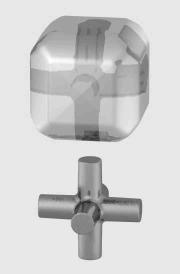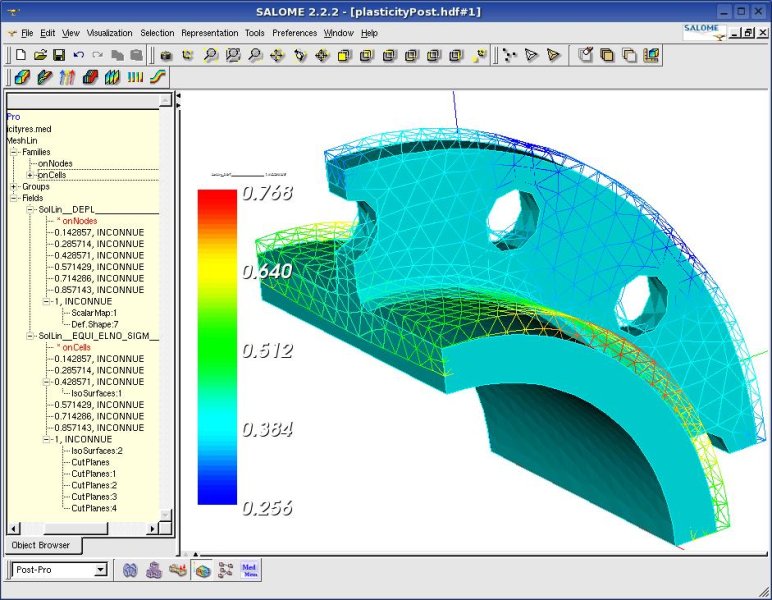|
FreeCAD (software)
FreeCAD is a general-purpose parametric 3D computer-aided design (CAD) modeler and a building information modeling (BIM) software application with finite element method (FEM) support. It is intended for mechanical engineering product design but also expands to a wider range of uses around engineering, such as architecture or electrical engineering. FreeCAD is free and open-source, under the LGPL-2.0-or-later license, and available for Linux, macOS, and Windows operating systems. Users can extend the functionality of the software using the Python programming language. Features General FreeCAD features tools similar to CATIA, Creo, SolidWorks, Solid Edge, NX, Inventor, Revit, and therefore also falls into the category of building information modeling (BIM), mechanical computer-aided design (MCAD), PLM, CAx and CAE. It is intended to be a feature-based parametric modeler with a modular software architecture, which makes it easy to provide additional functionality w ... [...More Info...] [...Related Items...] OR: [Wikipedia] [Google] [Baidu] |
Python (programming Language)
Python is a high-level, general-purpose programming language. Its design philosophy emphasizes code readability with the use of significant indentation. Python is dynamically-typed and garbage-collected. It supports multiple programming paradigms, including structured (particularly procedural), object-oriented and functional programming. It is often described as a "batteries included" language due to its comprehensive standard library. Guido van Rossum began working on Python in the late 1980s as a successor to the ABC programming language and first released it in 1991 as Python 0.9.0. Python 2.0 was released in 2000 and introduced new features such as list comprehensions, cycle-detecting garbage collection, reference counting, and Unicode support. Python 3.0, released in 2008, was a major revision that is not completely backward-compatible with earlier versions. Python 2 was discontinued with version 2.7.18 in 2020. Python consistently ranks as ... [...More Info...] [...Related Items...] OR: [Wikipedia] [Google] [Baidu] |
Finite Element Method
The finite element method (FEM) is a popular method for numerically solving differential equations arising in engineering and mathematical modeling. Typical problem areas of interest include the traditional fields of structural analysis, heat transfer, fluid flow, mass transport, and electromagnetic potential. The FEM is a general numerical method for solving partial differential equations in two or three space variables (i.e., some boundary value problems). To solve a problem, the FEM subdivides a large system into smaller, simpler parts that are called finite elements. This is achieved by a particular space discretization in the space dimensions, which is implemented by the construction of a mesh of the object: the numerical domain for the solution, which has a finite number of points. The finite element method formulation of a boundary value problem finally results in a system of algebraic equations. The method approximates the unknown function over the domain. The sim ... [...More Info...] [...Related Items...] OR: [Wikipedia] [Google] [Baidu] |
Solid Modeling
Solid modeling (or solid modelling) is a consistent set of principles for mathematical and computer modeling of three-dimensional shapes '' (solids)''. Solid modeling is distinguished from related areas of geometric modeling and computer graphics, such as ''3D modeling'', by its emphasis on physical fidelity. Together, the principles of geometric and solid modeling form the foundation of 3D-computer-aided design and in general support the creation, exchange, visualization, animation, interrogation, and annotation of digital models of physical objects. Overview The use of solid modeling techniques allows for the automation process of several difficult engineering calculations that are carried out as a part of the design process. Simulation, planning, and verification of processes such as machining and assembly were one of the main catalysts for the development of solid modeling. More recently, the range of supported manufacturing applications has been greatly expanded to incl ... [...More Info...] [...Related Items...] OR: [Wikipedia] [Google] [Baidu] |
Computer-aided Engineering
Computer-aided engineering (CAE) is the broad usage of computer software to aid in engineering analysis tasks. It includes , , , durability and optimization. It is included with computer-aided design (CAD) and computer-aided manufacturing (CAM) in the collective abbreviation " CAx". Overview Computer-aided engineering primarily uses computer-aided design (CAD) software, which are sometimes called CAE tools. CAE tools are used, to analyze the robustness and performance of components and assemblies. CAE tools encompass simulation, validation, and optimization of products and manufacturing tools. CAE systems aim to be major providers of information to help support design teams in decision-making. Computer-aided engineering is used in various fields, like automotive, aviation, space, and shipbuilding industries. CAE systems can provide support to businesses. This is achieved by the use of reference architectures and their ability to place information views on the business proc ... [...More Info...] [...Related Items...] OR: [Wikipedia] [Google] [Baidu] |
Product Lifecycle Management
In industry, Product Lifecycle Management (PLM) is the process of managing the entire lifecycle of a product from its inception through the engineering, design and manufacture, as well as the service and disposal of manufactured products. PLM integrates people, data, processes and business systems and provides a product information backbone for companies and their extended enterprises. History The inspiration for the burgeoning business process now known as PLM came from American Motors Corporation (AMC). The automaker was looking for a way to speed up its product development process to compete better against its larger competitors in 1985, according to François Castaing, Vice President for Product Engineering and Development. Lacking the "massive budgets of General Motors, Ford, and foreign competitors … AMC placed R&D emphasis on bolstering the product lifecycle of its prime products (particularly Jeeps)." After introducing its compact Jeep Cherokee (XJ), the vehicle th ... [...More Info...] [...Related Items...] OR: [Wikipedia] [Google] [Baidu] |
Autodesk Revit
Autodesk Revit is a building information modelling software tool for architects, landscape architects, structural engineers, mechanical, electrical, and plumbing (MEP) engineers, designers and contractors. The original software was developed by Charles River Software, founded in 1997, renamed Revit Technology Corporation in 2000, and acquired by Autodesk in 2002. The software allows users to design a building and structure and its components in 3D, annotate the model with 2D drafting elements, and access building information from the building model's database. Revit is 4D building information modeling application capable with tools to plan and track various stages in the building's lifecycle, from concept to construction and later maintenance and/or demolition. Company history Charles River Software was founded in Newton, Massachusetts, on October 31, 1997, by Leonid Raiz and Irwin Jungreis, key developers of PTC's Pro/Engineer software for mechanical design, with the intent o ... [...More Info...] [...Related Items...] OR: [Wikipedia] [Google] [Baidu] |
Autodesk Inventor
Autodesk Inventor is a computer-aided design application for 3D mechanical design, simulation, visualization, and documentation developed by Autodesk. Features Inventor allows 2D and 3D data integration in a single environment, creating a virtual representation of the final product that enables users to validate the form, fit, and function of the product before it is ever built. Autodesk Inventor includes parametric, direct edit and freeform modeling tools as well as multi-CAD translation capabilities and in their standard DWG drawings. Inventor uses ShapeManager, Autodesk's proprietary geometric modeling kernel. Autodesk Inventor competes directly with SolidWorks, Solid Edge, and Creo. Editions The latest Autodesk Inventor product line includes the following software titles: *Autodesk Inventor LT 2021 (discontinued) *Autodesk Inventor Professional 2023 Release dates and names See also * Comparison of CAD editors for architecture, engineering and construction (AEC) ... [...More Info...] [...Related Items...] OR: [Wikipedia] [Google] [Baidu] |
Siemens NX
NX, formerly known as "unigraphics", is an advanced high-end CAD/CAM/ CAE, which has been owned since 2007 by Siemens Digital Industries Software. In 2000, Unigraphics purchased SDRC I-DEAS and began an effort to integrate aspects of both software packages into a single product which became Unigraphics NX or NX. It is used, among other tasks, for: * Design (parametric and direct solid/surface modelling) * Engineering analysis (static; dynamic; electro-magnetic; thermal, using the finite element method; and fluid, using the finite volume method). * Manufacturing finished design by using included machining modules. NX is a direct competitor to CATIA, Creo, Autodesk Inventor. History 1972: United Computing, Inc. releases UNIAPT, one of the world's first end-user CAM products. 1973: The company purchases the Automated Drafting and Machining (ADAM) software code from MCS in 1973. The code became a foundation for a product called UNI-GRAPHICS, later sold commercially as Unigraphic ... [...More Info...] [...Related Items...] OR: [Wikipedia] [Google] [Baidu] |
Solid Edge
Solid Edge is a 3D CAD, parametric feature and synchronous technology solid modeling software. It runs on Microsoft Windows and provides solid modeling, assembly modelling and 2D orthographic view functionality for mechanical designers. Through third party applications it has links to many other Product Lifecycle Management (PLM) technologies. Originally developed and released by Intergraph in 1996 using the ACIS geometric modeling kernel, it changed to using the Parasolid kernel when it was purchased and further developed by UGS Corp in 1998. In 2007, UGS was acquired by the Automation & Drives Division of Siemens AG. UGS company was renamed Siemens Digital Industries Software on October 1, 2007. Since September 2006, Siemens has also offered a free 2D version called Solid Edge 2D Drafting. Solid Edge is available in Design and Drafting, Foundation, Classic or Premium. The "Premium" package includes all of the features of "Classic" plus mechanical and electrical routing sof ... [...More Info...] [...Related Items...] OR: [Wikipedia] [Google] [Baidu] |
SolidWorks
SolidWorks is a solid modeling computer-aided design (CAD) and computer-aided engineering (CAE) application published by Dassault Systèmes. According to the publisher, over two million engineers and designers at more than 165,000 companies were using SolidWorks as of 2013. According to the company, fiscal year 2011–12 revenue for SolidWorks totaled $483 million. History SolidWorks Corporation was founded in December 1993 by Massachusetts Institute of Technology graduate Jon Hirschtick. Hirschtick used $1 million he had made while a member of the MIT Blackjack Team to set up the company. Initially based in Waltham, Massachusetts, United States, Hirschtick recruited a team of engineers with the goal of building 3D CAD software that was easy-to-use, affordable, and available on the Windows desktop. Operating later from Concord, Massachusetts, SolidWorks released its first product ''SolidWorks 95'', in November 1995. [...More Info...] [...Related Items...] OR: [Wikipedia] [Google] [Baidu] |
Creo (design Software)
Creo is a family of Computer-aided design (CAD) apps supporting product design for discrete manufacturers and is developed by PTC. The suite consists of apps, each delivering a distinct set of capabilities for a user role within product development. Creo runs on Microsoft Windows and provides apps for 3D CAD parametric feature solid modeling, 3D direct modeling, 2D orthographic views, Finite Element Analysis and simulation, schematic design, technical illustrations, and viewing and visualization. Creo can also be paired with Mastercam (Machining based software) to machine any designed model in a minimal timeframe. Software and features Creo Elements and Creo Parametric compete directly with CATIA, Siemens NX/ Solid Edge, and SolidWorks. The Creo suite of apps replace and supersede PTC’s products formerly known as Pro/ENGINEER, CoCreate, and ProductView. Creo has many different software package solutions and featuresCreo Illustrateis a good example. Creo Parametr ... [...More Info...] [...Related Items...] OR: [Wikipedia] [Google] [Baidu] |
CATIA
CATIA (, an acronym of computer-aided three-dimensional interactive application) is a multi-platform software suite for computer-aided design (CAD), computer-aided manufacturing (CAM), computer-aided engineering (CAE), 3D modeling and Product lifecycle management (PLM), developed by the French company Dassault Systèmes. Since it supports multiple stages of product development from conceptualization, design and engineering to manufacturing, it is considered a CAx-software and is sometimes referred to as a 3D Product Lifecycle Management software suite. Like most of its competition it facilitates collaborative engineering through an integrated cloud service and have support to be used across disciplines including surfacing & shape design, electrical, fluid and electronic systems design, mechanical engineering and systems engineering. Besides being used in a wide range of industries from aerospace and defence to packaging design, CATIA has been used by architect Frank Gehry to de ... [...More Info...] [...Related Items...] OR: [Wikipedia] [Google] [Baidu] |
.png)





